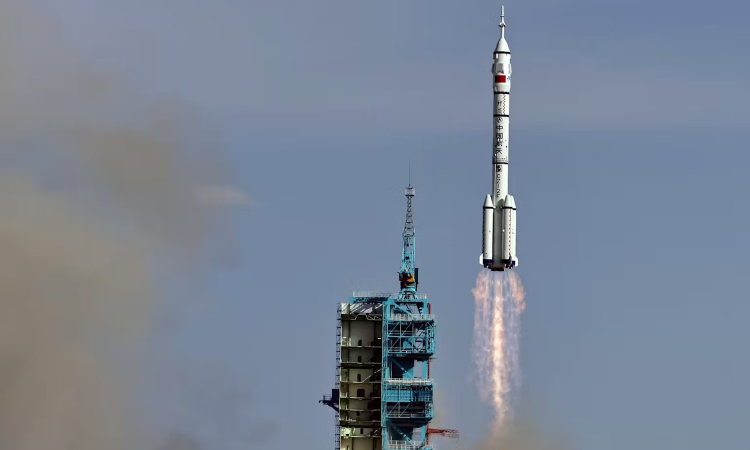Celestial rivalry: China’s steady march to the Moon
Among US lawmakers and space officials, Beijing’s accelerating progress has stirred unease. Some warn that if China lands first, it could damage America’s long-held prestige as a spacefaring superpower.

More than half a century after humans last set foot on the Moon, China is moving purposefully toward its own crewed lunar landing. On October 30, 2025, a spokesman for China’s crewed space programme announced the country was “on track” to send astronauts to the Moon by 2030. The statement underscored what has become increasingly clear: China intends to be the next nation to walk on the lunar surface.
Among US lawmakers and space officials, Beijing’s accelerating progress has stirred unease. Some warn that if China lands first, it could damage America’s long-held prestige as a spacefaring superpower. NASA’s Artemis III mission, meant to return Americans to the Moon for the first time since Apollo 17 in 1972, is scheduled for 2027 — but delays could push it dangerously close to China’s timeline.
That proximity marks a remarkable rise for Beijing’s space program. China launched its first astronaut, Yang Liwei, aboard Shenzhou 5 in 2003. In just over two decades, it has moved from a single-astronaut flight to complex three-person missions and the construction of a permanent orbital outpost. The steady progression echoes the milestones that once defined the Cold War space race between the US and the Soviet Union.
Eyeing permanent foothold
China’s Tiangong space station, completed in low-Earth orbit in 2022, is now regularly crewed. On October 31, 2025, Shenzhou 21 launched three astronauts to relieve a crew that had been aboard since April — routine crew rotations that highlight the maturity of China’s program. When the International Space Station retires around 2030, Tiangong will likely stand as humanity’s sole permanent orbital base.
Yet even routine missions carry risk. The return of the previous Tiangong crew was delayed after their capsule was struck by space debris — a sobering reminder that space remains a hazardous frontier.
China’s progress is built on technological consistency. Since the 1970s, it has developed over 20 models in its Long March family of rockets, with 16 still active. According to China Daily, these rockets boast a 97% success rate — slightly below SpaceX’s Falcon 9 at 99.46%. This reliability has allowed China to plan long-term and meet ambitious deadlines.
In August 2025, China successfully conducted a ground test of its newest launcher, the Long March 10, designed to carry astronauts aboard the next-generation Mengzhou spacecraft. Mengzhou will replace the ageing Shenzhou capsule and is expected to debut in 2026 with an uncrewed test flight.
Next-Gen lunar system
Mengzhou consists of two modules: a crew module and a service module providing propulsion, power, and life support. It is designed for flexibility, with versions for near-Earth operations and deep-space missions. The crew module can carry up to six astronauts, twice the capacity of Shenzhou.
For lunar expeditions, Mengzhou will pair with a dedicated lunar lander named Lanyue, meaning “embracing the Moon,” a phrase drawn from a poem by Mao Zedong. Lanyue comprises two stages—a landing stage that carries astronauts, and a propulsion stage that provides fuel and detaches just before touchdown. Weighing nearly 26 tonnes, it will transport two astronauts to the lunar surface. Testing of the lander began in 2024, with robotic prototypes scheduled for 2027–2028 and an uncrewed Mengzhou-Lanyue flight planned for 2028 or 2029.
China is preparing its astronauts as meticulously as its hardware. In 2024, the China Manned Space Agency (CMSA) unveiled its lunar spacesuit in Chongqing. During the demonstration, a technician bent, crouched, and climbed stairs — showcasing the suit’s mobility and durability for Moon operations.
These human-spaceflight efforts build on an impressive robotic exploration record. The Chang’e program has already achieved several firsts, including the Chang’e-6 mission’s 2024 return of samples from the Moon’s far side—the first in history. That success solidified China’s reputation for technical competence and determination in space science.
Vision, resources, strategy
China’s lunar ambition rests on three pillars: a clear vision, stable funding, and long-term planning. The country was the second-highest spender on government space programs in 2024, investing $19 billion — a fraction of America’s $79 billion, yet directed through a centralised strategy largely insulated from political shifts.
While prestige remains part of the equation, a crewed Chinese Moon landing would also reshape the rules of engagement in space. “The countries that get there first will write the rules of the road for what we can do on the Moon,” former NASA associate administrator Mike Gold told a US Senate hearing.
If China plants its flag first, it will not only mark a triumph of engineering but also a turning point in geopolitical influence beyond Earth — a sign that leadership in space, like on Earth, is no longer America’s alone.
Martin is Analyst, Science and Emerging Technology Team, RAND Europe
The Conversation



